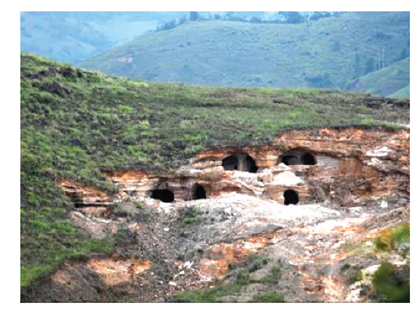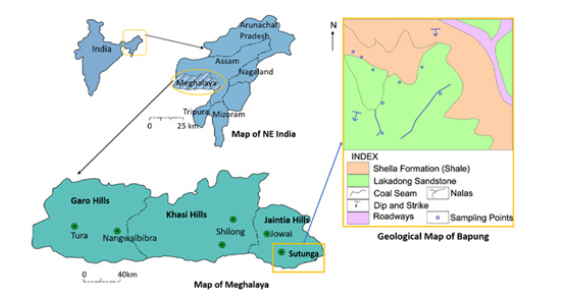- Submissions

Full Text
Aspects in Mining & Mineral Science
Mine Water Analysis of Coal-Bearing Strata of Sutunga Coalfield, East Jaintia Hills, Meghalaya, North East India
Manabendra Nath*
Department of Geology, India
*Corresponding author:Manabendra Nath, Department of Geology, Gurucharan College, Silchar, India
Submission: August 14, 2023: Published: September 05, 2023

ISSN 2578-0255Volume11 Issue5
Abstract
The water which seeks out from various Sutunga coalmines of East Jaintia Hills of Meghalaya were analysed. The water samples obtained from 7 different strategically selected sites. The pH of water of all sites varies from 1-3 which indicates it is highly acidic. The TDC and conductivity is also very high (TDC-480 to 190mg/L, conductivity - 800 to 300μ/cm). The heavy metals detected were Ca, Mg, Se, Pb, Fe, Ni, Cu, Mn, Co, Zn & Se. Use of this water (for drinking & domestic) by the mine workers and people of adjoining village is thus unsuitable & unsafe.
Keywords:Coalfield; Heavy metals; Polyethylene; Copper; Conductivity
Introduction
The Northeastern region of India possess a unique geological and geographical characteristic feature distinguishes from other parts of India [1]. The main natural resources of NE India are coal and petroleum. The Tertiary coal resources of this area spread over the states of Assam, Arunachal Pradesh, Meghalaya and Nagaland. Where the sulphur percentage is more than 3 which places it as high sulphur coal [2]. A little work has been done on the mine water analysis of coal bearing strata of these states [3-5]. The coal mining areas of the East Jaintia Hills of Meghalaya spread over the areas where from water is seeping through coal seams. Therefore, analysis of such water is very important for use by the mine workers and people of adjoining villages. This paper is an attempt to focus on the chemical characteristics of seepage water of Sutunga coal mines of East Jaintia Hills of Meghalaya (Figure 1).
Figure 1:Rat-hole mine in Sutunga area.

Geology of the study area
The Sutunga coalfield is situated in the east Jaintia Hills of Meghalaya and located at a distance of 84m from Shillong on the Jowai-Badarpur road. In the field, coal seams occur in the Lakadong Sandstone member of Shella Formation of the Jaintia Group. This member contains two coal seams ranging in thickness from 0.5m to 1.1m. The bottom seam is 0.5 to 1m thick and upper seam is 0.05 to 0.08m thick. The coal seams dip 20 to 30 towards SE. A generalised stratigraphic sequence is shown in Table 1. The geological map & location map of the area shown in Figure 1.
Table 1:Geological succession of Jaintia Hills coalfield of Meghalaya (modified after Raja Rao [1]; GSI [7]).

Experimental
Collection of samples
The samples were collected from seven different coal mines of the area in new one litre polyethylene containers after rinsing with distilled water.
Analysis
The pH of mine water was determined by WTW, ‘MERCK’ Germany make portable pH meter (model pH 320). The conductivity was measured by WTW, ‘MERCK’ Germany make portable conductivity meter (model LF 320). The TDS was measured in the laboratory by WTW, ‘MERCK’ Germany make portable meter (model LF 320). The heavy metals present in the mine water were determined by Perking Elmer Atomic Absorption Spectrometer (model 3110).
Result and Discussion
The results of mine water of coal-bearing strata of Sutunga area obtained from 7 strategically selected sites are furnished in Table 2 & 3. From the tables it is evident that pH value of all samples varies from 1-3 which indicate that seepage water from coal mines is highly acidic, and the corresponding conductivity varies from 305s/cm to 950s/cm and TDS varies from 150mg/L to 490mg/L. The higher TDS in the water indicates that ions are mostly in the form of dissolved sulphates. The upper limit of TDS recommended for drinking water is 147ppm by WHO [6]. Atomic Absorption Spectroscopic (AAS) study revealed the presence of as many as six heavy metals viz. Iron, Cobalt, Zinc, Manganese, Lead and Copper. Calcium and magnesium were found in all the samples analysed. The permissible safe limits of elements of potable water of Pb, Fe, Cu, Mn, Ca, Mg, Se and Zn are 0.01, 0.1, 0.23, 0.01, 23.00, 17.00, 0.01, 1.00 (in ppm) respectively by WHO, (1993) [5]. The heavy elements excluding Ca and Mg determined show that the water contamination is above the suggested guidelines. Selenium detected in site 5, 6, 7 is a noteworthy feature and is characteristic of NE region. This being toxic metal. The extent of degradation of water quality is discussed below (Figure 2).
Table 2:Mine water analysis results of Sutunga coal.

Table 3:Heavy metals in mine water of Sutunga coal (in ppm). ND=not detected.

Figure 2:Location and geological map of Sutunga coalfield.

Colour
The colour of the water in mining area generally varies from brownish to reddish orange. Siltation of coal particles, sand, soil etc. and contamination of AMD and formation of iron hydroxide are some of the major causes of change in water colour. Formation of iron hydroxides [(Fe (OH)3] is mainly responsible for orange or red colour of water in the mining areas. Iron hydroxide is a yellowish insoluble material commonly formed in water bodies of the coalfields. It is this material that stains streams and responsible for red to orange colour of water. When elevated levels of iron are introduced into natural waters, the iron is oxidized and hydrolysed, thereby forming precipitate of iron hydroxides.
pH
The water in coal mining areas has been found highly acidic. The pH of the area varies between 1.12-3.18. This indicates serious condition of the water bodies of the area that hardly can support any aquatic life such as fish, amphibians and insects. Contamination of Acid Mine Drainage (AMD) leads to acidity or low pH of the affected water bodies. Acidic water is a matter of primary concern since it can directly be injurious to aquatic organisms. It also facilitates leaching of toxic metals into the water that could be hazardous to aquatic life, directly or can disturb the habitat after precipitation [6,7].
High concentration of metals
Layers of rock and earth above the coal removed during mining commonly contain traces of iron, manganese, and aluminium and can also contain other heavy metals. These metals can be dissolved from mining sites through the action of acid runoff or can be washed into streams as sediment. Most of the water bodies in the coal mining area of Jaintia Hills have been found containing high concentration of various metals. Many metals, though common, can be toxic to fish and other aquatic organisms when present in high dissolved concentrations. Dissolved iron and iron precipitate, for example, can kill the aquatic biota that fish feed on, thus reducing the overall fish population.
Sulphate
The waters of the mining areas have been found containing sulphate concentration between 78 to 168mg/L. The high concentration of sulphates is mainly due to presence of iron sulphide in coal and its reaction with water and oxygen. As pyrite wastes are chemically broken down, sulphate ions are produced in runoff water. Sulphates combine with water molecules and form sulphuric acid or can attach to calcium atoms to form gypsum sludge. Sulphuric acid is mainly responsible for acidity of the contaminated water. Elevated sulphate levels have also been found in AMD contaminated rivers and streams of Jaintia Hills.
Electrical conductivity (EC)
Conductivity is the measure of the capacity of a solution to conduct electric current. It is a rapid measure of the total dissolved solids present in ionic form. In this study, the conductivity was found highest and least 820s/cm- 305s/cm.
Conclusion
The results of the investigation suggest that the water is highly acidic with large quantity of dissolved ions. Presence of heavy metals renders the water unsuitable and unsafe for drinking and other domestic uses.
Acknowledgment
The author wishes to express thanks to the RSIC, Shillong for heavy metal analysis.
References
- Raja Rao CS (1981) Geol Surv India. Bull Ser A 45: 75.
- Chou CL (2012) Sulphur in coals: A review of Geochemistry and origins. International Journal for Coal Geology 100: 1-13.
- Ahmed M (1984) Indo-Polish Symposium on application of Geological and Geophysical techniques to ISM, Dhanbad, Jharkhand, India, p. 32.
- Nath M, Ahmed M (2001) Proc ICCE Int Conference on Chemistry and Environment, Indore, India, pp. 86-87.
- Rawat NS (1981) Short-term course on Geomicrobiology ISM, Dhandad, Jharkhand, India, p. 84.
- WHO (2011) Guidelines for Drinking Water Quality. World Health Organisation, Geneva, Switzerland.
- GSI (2009) Geology and Mineral resources of Meghalaya. Geological Survey of India. Miscellaneous Publication, No. 3, Part IV, 2(2):
© 2023 Manabendra Nath. This is an open access article distributed under the terms of the Creative Commons Attribution License , which permits unrestricted use, distribution, and build upon your work non-commercially.
 a Creative Commons Attribution 4.0 International License. Based on a work at www.crimsonpublishers.com.
Best viewed in
a Creative Commons Attribution 4.0 International License. Based on a work at www.crimsonpublishers.com.
Best viewed in 







.jpg)






























 Editorial Board Registrations
Editorial Board Registrations Submit your Article
Submit your Article Refer a Friend
Refer a Friend Advertise With Us
Advertise With Us
.jpg)






.jpg)














.bmp)
.jpg)
.png)
.jpg)










.jpg)






.png)

.png)



.png)






